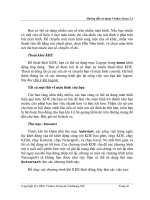Hướng dẫn sử dụng Kali - kali linux
Bạn đang xem bản rút gọn của tài liệu. Xem và tải ngay bản đầy đủ của tài liệu tại đây (4.9 MB, 668 trang )
Digital Forensics
Penetration Testing
@Aleks_Cudars
Last updated: 25.04.2013
NB!
• This reference guide describes every tool one by one and is aimed at anyone who wants to get familiar with digital forensics and penetration
testing or refresh their knowledge in these areas with tools available in Kali Linux
• Note! I’ve tried to gather as much information as possible, however, even despite that, some entries don’t have information, which I might update
if I get more information. Also, mistakes are inevitable
• The purpose was to create the most detailed source of every tool in Kali Linux for quick reference and better understanding
• Some tools fall under several categories, which means that duplicate entries exist in the full ~670 pages long source
• The information about every tool usually consists of: DESCRIPTION, USAGE, EXAMPLE and sometimes OPTIONS and TIPs
• Kali Linux tools are not limited to Kali Linux / Backtrack (most can be installed on other Linux distributions taking into consideration all the
necessary dependencies. Additionally, some tools are also available on other types of operating systems such as Windows and Mac OS)
• Kali Linux is a new and developing OS – some tools may be added, some - updated, some – removed over time
• It is assumed that all tools are run as root (or as administrator) (in Kali Linux you are root by default)
• All the information gathered about each tool has been found freely on the Internet and is publicly available
• Sources of information are referenced at the end
• Most command line tools include options, however, due to space considerations, only some tools have options listed (search the internet for
options, read documentation/manual, use –h or help)
• For more information on each tool - search the internet, click on links or check the references at the end
• PLEASE DO NOT USE KALI LINUX AND THE TOOLS LISTED HERE FOR ANY ILLEGAL OPERATION!
• Tools which are specifically aimed at DOS, DDOS or anonymity are rarely used in legitimate engagements, and are
therefore not installed by default in Kali Linux
List of Tools for Kali Linux 2013 2
[01] INFORMATION GATHERING - DNS ANALYSIS
• dnsdict6
• dnsenum
• dnsmap
• dnsrecon
• dnsrevenum6
• dnstracer
• dnswalk
• fierce
• maltego
• nmap
• urlcrazy
3 List of Tools for Kali Linux 2013
dnsdict6
DESCRIPTION thc-ipv6 - THC-IPV6-ATTACK-TOOLKIT - just run the tools without options and they will give you help
and show the command line options.
The tool is used to enumerate domain to get the IPv6 address , if it exists. It is a parallized DNS IPv6 dictionary
bruteforcer.
TIP DETECTION
Most tools can easily be detected by an IDS or specialized detection software. This is done on purpose to make
rogue usage detection easier. The tools either specify a fixed packet signature, or generically sniff for packets (e.g.
therefore also answering to icmp6 neighbour solicitations which are sent to a non-existing mac, and are therefore
very easy to detect). If you don't want this, change the code.
USAGE dnsdict6 <url>
USAGE dnsdict6 [-d46] [-s|-m|-l|-x] [-t THREADS] [-D] domain [dictionary-file]
EXAMPLE dnsdict6 google.com
4 List of Tools for Kali Linux 2013
dnsenum
5 List of Tools for Kali Linux 2013
DESCRIPTION The purpose of dnsenum is to gather as much information as possible about a domain. The
program currently performs the following operations:
• Get the host's address (A record) / get name servers (threaded) / get the MX record (threaded).
• Perform axfr queries on name servers and get BIND versions(threaded).
• Get extra names and subdomains via google scraping (google query = "allinurl: -www site:domain").
• Brute force subdomains from file, can also perform recursion on subdomain that have NS records (all
threaded).
• Calculate C class domain network ranges and perform whois queries on them (threaded).
• Perform reverse lookups on network ranges ( C class or/and whois netranges) (threaded).
• Write to domain_ips.txt file ip-blocks.
USAGE dnsenum.pl [options] <domain>
EXAMPLE ./dnsenum.pl -p 1 -s 1 google.com
dnsmap
6 List of Tools for Kali Linux 2013
DESCRIPTION The tool enables to discover all subdomains associated to a given domain (e.g. from google.com, it is
possible to discover mail.google.com, earth.google.com, sketchup.google.com, desktop.google.com, ).
USAGE ./dnsmap <target-domain> [options]
EXAMPLE ./dnsmap google.com
dnsrecon
7 List of Tools for Kali Linux 2013
DESCRIPTION dnsrecon enables to gather DNS-oriented information on a given target.
At the time of this writing (version 1.6), the tool supports following types:
• Brute force hostnames and subdomains of a given target domain using a wordlist.
• Standard Record Enumeration for a given domain (A, NS, SOA and MX).
• Top Leven Domain Expansion for a given domain.
• Zone Transfer against all NS records of a given domain.
• Reverse Lookup against a given IP Range given a start and end IP.
• SRV Record enumeration
USAGE ./dnsrecon.rb -t <type> -d <target> [options]
EXAMPLE ./dnsrecon.rb -t std -d google.com (Standard (-t std))
EXAMPLE ./dnsrecon.rb -t tld -d aldeid (Top Level Domain (-t tld))
EXAMPLE ./dnsrecon.rb -t axfr -d ??????club.net (Zone transfer (-t axfr))
EXAMPLE ./dnsrecon.rb -t rvs -i 66.249.92.100,66.249.92.150 (Reverse Record Enumeration (-t rvs))
dnsrevenum6
8 List of Tools for Kali Linux 2013
DESCRIPTION thc-ipv6 - THC-IPV6-ATTACK-TOOLKIT - just run the tools without options and they will give you help
and show the command line options.
Simple and fast Reverse DNS Enumerator for IPv6
• detects wildcard DNS servers
• adapts to lossy/slow DNS server
• fast but non-flooding
• specify the reverse domain as 2001:db8::/56 or 0.0.0.0.8.b.d.0.1.0.0.2.ip6.arpa
TIP DETECTION
Most tools can easily be detected by an IDS or specialized detection software. This is done on purpose to make
rogue usage detection easier. The tools either specify a fixed packet signature, or generically sniff for packets (e.g.
therefore also answering to icmp6 neighbour solicitations which are sent to a non-existing mac, and are therefore
very easy to detect). If you don't want this, change the code.
USAGE dnsrevenum6 <url>
EXAMPLE dnsrevenum6 google.com
dnstracer
9 List of Tools for Kali Linux 2013
DESCRIPTION dnstracer enables to trace a chain of DNS servers to the source. It determines where a given Domain
Name Server (DNS) gets its information from, and follows the chain of DNS servers back to the servers which know
the data.
USAGE dnstracer [options] name
EXAMPLE dnstracer www.mavetju.org (Search for the A record of www.mavetju.org on your local nameserver)
EXAMPLE dnstracer "-s" . "-q" mx mavetju.or (Search for the MX record of mavetju.org on the root-nameservers)
EXAMPLE dnstracer "-q" ptr 141.230.204.212.in-addr.arpa (Search for the PTR record (hostname) of 212.204.230.141)
EXAMPLE dnstracer "-q" ptr "-s" . "-o“ 2.0.0.0.0.0.0.0.0.0.0.0.0.0.0.0.0.6.4.0.2.0.0.0.0.8.b.0.e.f.f.3.ip6.int (for IPv6 addresses)
dnswalk
10 List of Tools for Kali Linux 2013
DESCRIPTION Dnswalk is a DNS database debugger. It performs zone transfers of specified domains, and checks
the database in numerous ways for internal consistency, as well as for correctness according to accepted
practices with the Domain Name System.
The domain name specified on the command line MUST end with a '.'. You can specify a forward domain, such as
dnswalk podunk.edu. or a reverse domain, such as dnswalk 3.2.1.in-addr.arpa.
USAGE dnswalk [ -adilrfFm ] <domain>.
EXAMPLE dnswalk google.com
fierce
11 List of Tools for Kali Linux 2013
DESCRIPTION fierce is a semi-lightweight enumeration scanner that helps penetration testers locate non-
contiguous IP space and hostnames for a specified domains using things like DNS, Whois and ARIN. It's really
meant as a pre-cursor to active testing tools via something like: nmap, unicornscan, nessus, nikto, etc, since all
of those require that you already know what IP space you are looking for. Fierce does not perform exploitation
and does not scan the whole internet indiscriminately. It is meant specifically to locate likely targets both inside
and outside a corporate network.
Since it uses DNS primarily you will often find mis-configured networks that leak internal address space.
USAGE fierce {target options} [OPTIONS]
EXAMPLE fierce -dns company.com (Standard Fierce scan)
EXAMPLE fierce -dns company.com –wide (Standard Fierce scan and search all class c ranges found for PTR names that match the domain)
EXAMPLE fierce -dns company.com -only zt (Fierce scan that only checks for zone transfer)
EXAMPLE fierce -dns company.com –ztstop (Fierce scan that does not perform bruteforcing if a zone transfer is found)
EXAMPLE fierce -dns company.com –wildcstop (Fierce scan that does not perform bruteforcing if a wildcard is found)
maltego
12 List of Tools for Kali Linux 2013
DESCRIPTION Maltego is a unique platform developed to deliver a clear threat picture to the environment that an
organization owns and operates. Maltego can locate, aggregate and visualize this information. Maltego is a
program that can be used to determine the relationships and real world links between people, groups of people
(social networks), companies, organizations, web sites, phrases, affiliations, documents and files, internet
infrastructure (domains, DNS names, netblocks, IP addresses).
USAGE n/a, GUI tool
EXAMPLE n/a, GUI tool
nmap
13 List of Tools for Kali Linux 2013
DESCRIPTION nmap is certainly THE scanner to know. Thanks to its numerous parameters, it is a swiss army knife
to all situations where network identification is needed. It enables among other things to list network hosts and
scan their ports.
USAGE ./nmap [Scan Type(s)] [Options] {target specification}
EXAMPLE ./nmap -sP 192.168.100.0/24 (Lists hosts on a network)
EXAMPLE ./nmap -sS -sV 192.168.100.18 (Scans a host. This example uses a TCP/SYN scan and tries to identify installed services)
urlcrazy
14 List of Tools for Kali Linux 2013
DESCRIPTION Generate and test domain typos and variations to detect and perform typo squatting, URL hijacking,
phishing, and corporate espionage.
• Detect typo squatters profiting from typos on your domain name
• Protect your brand by registering popular typos
• Identify typo domain names that will receive traffic intended for another domain
• Conduct phishing attacks during a penetration test
USAGE ./urlcrazy [options] <domain>
EXAMPLE ./urlcrazy example.com
[02] INFORMATION GATHERING - IDS/IPS IDENTIFICATION
• fragroute
• fragrouter
• wafw00f
15 List of Tools for Kali Linux 2013
fragroute
List of Tools for Kali Linux 2013 16
DESCRIPTION fragroute intercepts, modifies, and rewrites egress traffic destined for a specified host.
It features a simple ruleset language to delay, duplicate, drop, fragment, overlap, print, reorder, segment, source-
route, or otherwise monkey with all outbound packets destined for a target host, with minimal support for
randomized or probabilistic behaviour.
This tool was written in good faith to aid in the testing of network intrusion detection systems, firewalls, and basic
TCP/IP stack behaviour.
Unlike fragrouter, this program only affects packets originating from the local machine destined for a remote
host. Do not enable IP forwarding on the local machine.
USAGE fragroute [-f file] <host>
EXAMPLE fragroute 192.168.123.233
fragrouter
17 List of Tools for Kali Linux 2013
DESCRIPTION Fragrouter is a network intrusion detection evasion toolkit. It implements most of the attacks
described in the Secure Networks "Insertion, Evasion, and Denial of Service: Eluding Network Intrusion Detection"
paper of January 1998.
This program was written in the hopes that a more precise testing methodology might be applied to the area of
network intrusion detection, which is still a black art at best.
To test your firewall(s) using fragrouter , you will need two systems in addition to your firewall/packet filter. This is
because fragrouter cannot by design be run on the same system from which you're testing (according to the
documentation, this is to prevent abuse).
USAGE fragrouter [options]
EXAMPLE fragrouter -F1
wafw00f
18 List of Tools for Kali Linux 2013
DESCRIPTION
Web Application Firewalls (WAFs) can be detected through stimulus/response testing scenarios. Here is a short
listing of possible detection methods:
• Cookies: Some WAF products add their own cookie in the HTTP communication.
• Server Cloaking: Altering URLs and Response Headers
• Response Codes: Different error codes for hostile pages/parameters values
• Drop Action: Sending a FIN/RST packet (technically could also be an IDS/IPS)
• Pre Built-In Rules: Each WAF has different negative security signatures
WafW00f is based on these assumptions to determine remote WAFs.
USAGE python wafw00f.py <url>
EXAMPLE python wafw00f.py google.com
[03] INFORMATION GATHERING - LIVE HOST IDENTIFICATION
• alive6
• arping
• cdpsnarf
• detect-new-ip-6
• detect-sniffer6
• dmitry
• dnmap-client
• dnmap-server
• fping
• hping3
• inverse_lookup6
• miranda
• ncat
• netdiscover
• nmap
• passive_discovery6
• thcping6
• wol-e
• xprobe2
19 List of Tools for Kali Linux 2013
alive6
20 List of Tools for Kali Linux 2013
DESCRIPTION thc-ipv6 - THC-IPV6-ATTACK-TOOLKIT - just run the tools without options and they will give you help
and show the command line options.
alive6 shows alive addresses in the segment. If you specify a remote router, the packets are sent with a routing
header prefixed by fragmentation.
TIP DETECTION
Most tools can easily be detected by an IDS or specialized detection software. This is done on purpose to make
rogue usage detection easier. The tools either specify a fixed packet signature, or generically sniff for packets (e.g.
therefore also answering to icmp6 neighbour solicitations which are sent to a non-existing mac, and are therefore
very easy to detect). If you don't want this, change the code.
USAGE alive6 [-dlmrS] [-W TIME] [-i FILE] [-o FILE] [-s NUMBER] interface [unicast-or-multicast-address [remote-
router]]
EXAMPLE alive6 eth1
arping
21 List of Tools for Kali Linux 2013
DESCRIPTION arping pings a destination by sending ARP REQUEST packets to a neighbour host, using a given
source address.
USAGE arping [-fqbDUAV] [-c count] [-w timeout] [-I device] [-s source] destination
EXAMPLE arping -f -c 1 -I wlan0 192.168.100.1 (Host 192.168.100.1 is alive -> Received 1 response(s))
EXAMPLE arping -f -c 1 -I eth0 192.168.100.2 (Host 192.168.100.2 isn't alive -> Received 0 response(s))
cdpsnarf
22 List of Tools for Kali Linux 2013
DESCRIPTION CDPSnarf if a network sniffer exclusively written to extract information from CDP packets. It
provides all the information a “show cdp neighbors detail” command would return on a Cisco router and even
more.
Features: Time intervals between CDP advertisements, Source MAC address, CDP Version, TTL, Checksum, Device ID,
Software version, Platform, Addresses, Port ID, Capabilities, Duplex, Save packets in PCAP dump file format, Read packets
from PCAP dump files, Debugging information (using the "-d" flag), Tested with IPv4 and IPv6
USAGE cdpsnarf -i <device>
OPTIONS cdpsnarf -h
EXAMPLE ./cdpsnarf eth2
detect-new-ip-6
23 List of Tools for Kali Linux 2013
DESCRIPTION thc-ipv6 - THC-IPV6-ATTACK-TOOLKIT - just run the tools without options and they will give you help
and show the command line options.
This tool detects new IPv6 addresses joining the local network. If script is supplied, it is executed with the
detected IPv6 address as option.
TIP DETECTION
Most tools can easily be detected by an IDS or specialized detection software. This is done on purpose to make
rogue usage detection easier. The tools either specify a fixed packet signature, or generically sniff for packets (e.g.
therefore also answering to icmp6 neighbour solicitations which are sent to a non-existing mac, and are therefore
very easy to detect). If you don't want this, change the code.
USAGE detect-new-ip6 <interface> [script]
EXAMPLE detect-new-ip6 eth0
detect-sniffer6
24 List of Tools for Kali Linux 2013
DESCRIPTION thc-ipv6 - THC-IPV6-ATTACK-TOOLKIT - just run the tools without options and they will give you help
and show the command line options.
detect-sniffer6 - tests if systems on the local LAN are sniffing. Works against Windows, Linux, OS/X and *BSD. If
no target is given, the link-local-all-nodes address is used, which however rarely works.
USAGE detect-sniffer6 interface [target6]
EXAMPLE n/a
TIP DETECTION
Most tools can easily be detected by an IDS or specialized detection software. This is done on purpose to make
rogue usage detection easier. The tools either specify a fixed packet signature, or generically sniff for packets (e.g.
therefore also answering to icmp6 neighbour solicitations which are sent to a non-existing mac, and are therefore
very easy to detect). If you don't want this, change the code.
DMitry
25 List of Tools for Kali Linux 2013
DESCRIPTION DMitry has the ability to gather as much information as possible about a host. Base functionality is
able to gather possible subdomains, email addresses, uptime information, TCP port scan, whois lookups, and
more. The information are gathered with following methods:
• Perform an Internet Number whois lookup.
• Retrieve possible uptime data, system and server data.
• Perform a SubDomain search on a target host.
• Perform an E-Mail address search on a target host.
• Perform a TCP Portscan on the host target.
• A Modular program allowing user specified modules
USAGE dmitry [options] <file> <url>
EXAMPLE dmitry –help (DMitry help)
EXAMPLE man dmitry (DMitry complete documentation)
EXAMPLE dmitry -iwns -o example.out google.com









